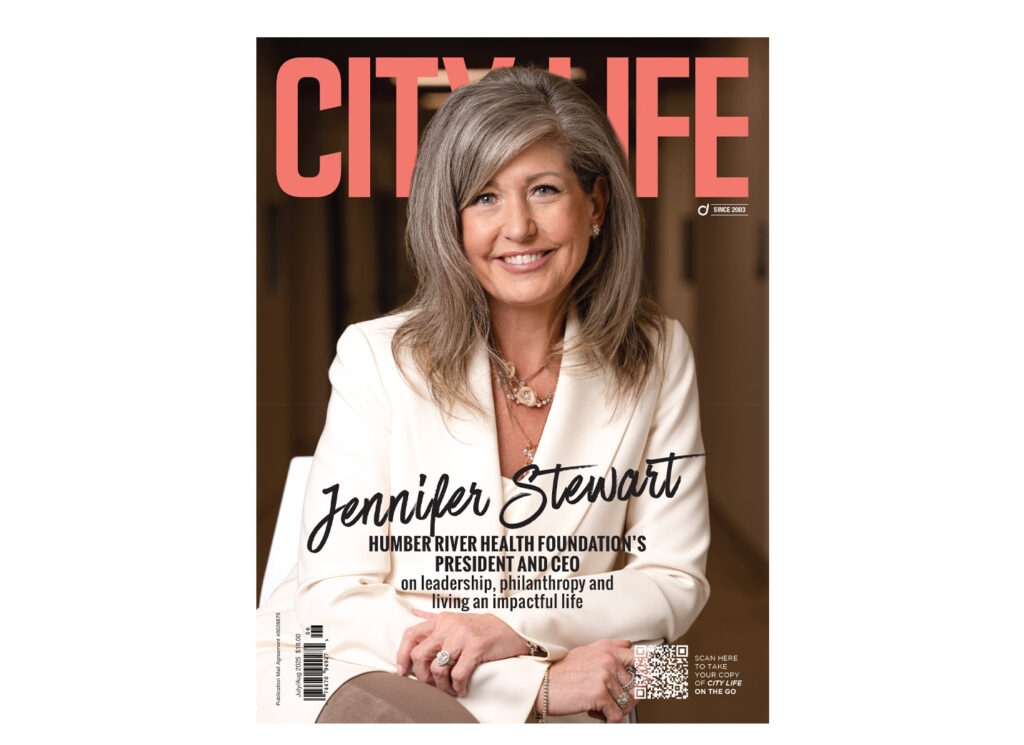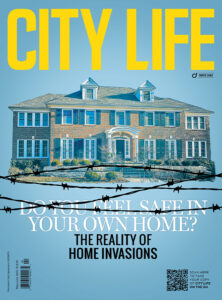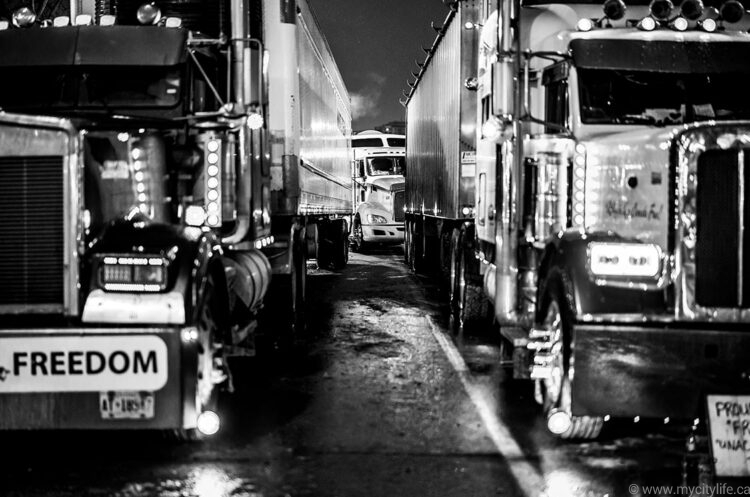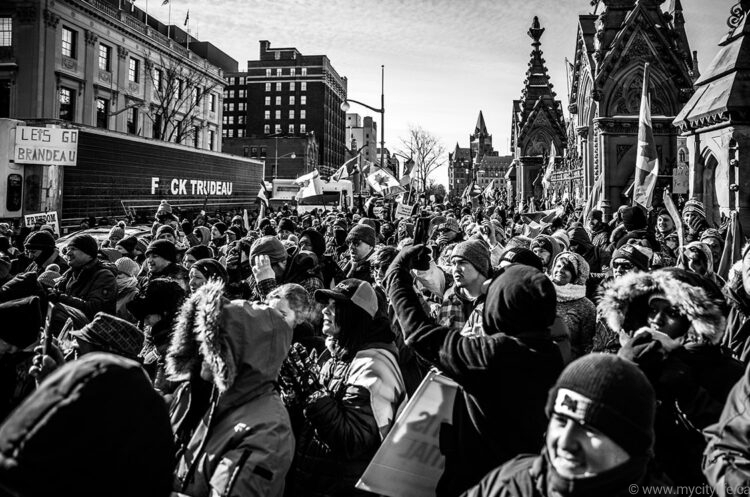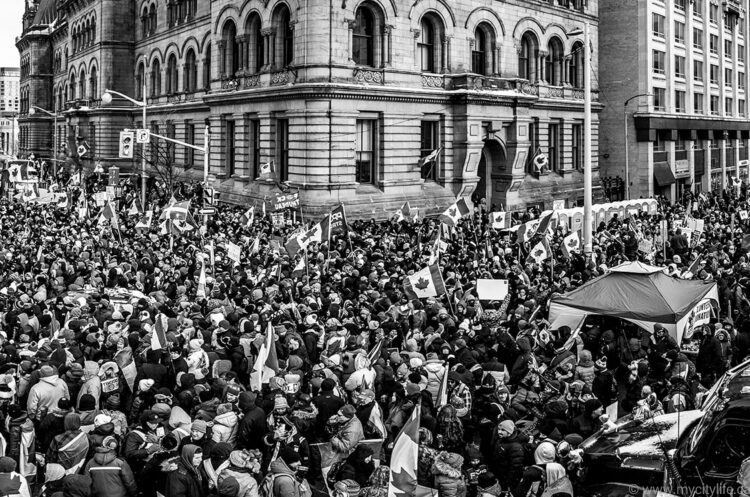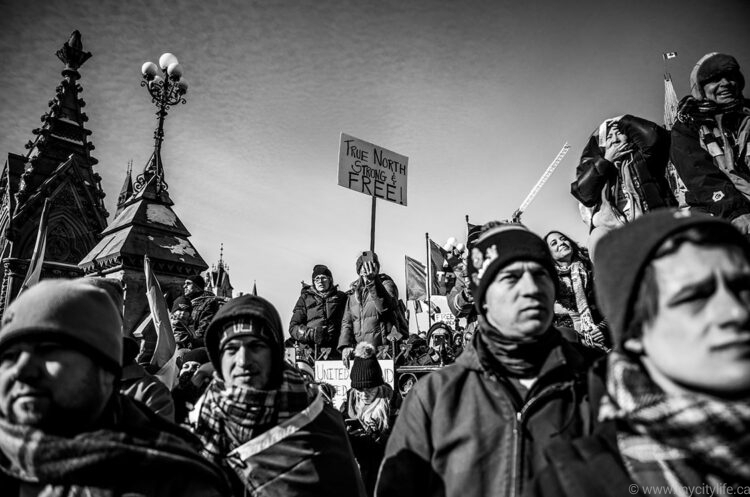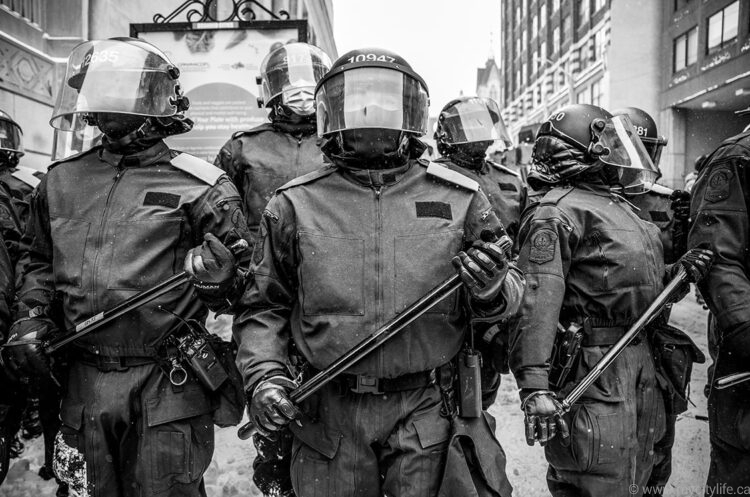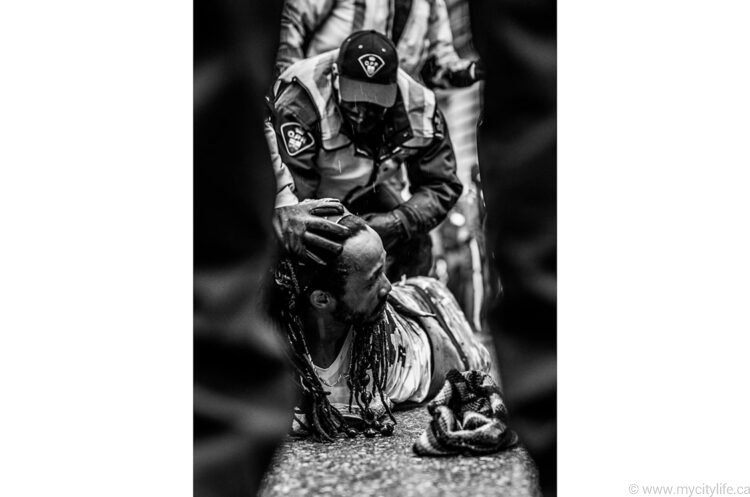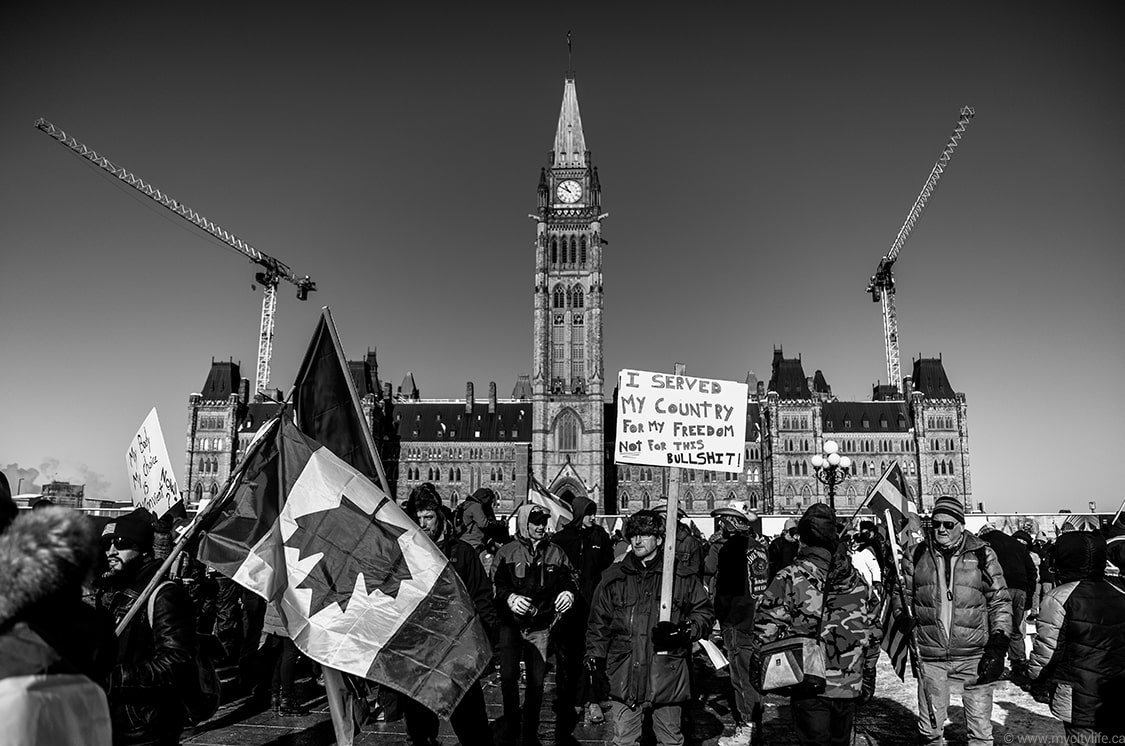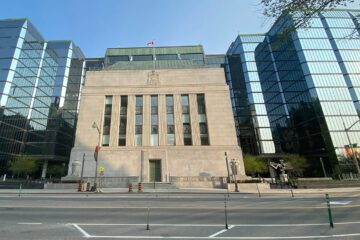Freedoms Collide. Freedoms Divide
Has our country unwittingly lost its reputation as Canada the good, a population of amiable citizens who are known for their championship of human rights, their civility, polite deportment and apologist behaviours?
How did a grassroots movement, whose original intent was to gather at cities and towns along the 9,000-kilometre border between Canada and the United States in support of unvaccinated cross-border truckers, morph into the hijacked version of what has become popularly known as the “Freedom Convoy”?
Based on their beliefs and value systems, these truckers, who represent about 10 per cent of the 120,000 cross-border truckers who go back and forth between Canada and the United States on a regular basis, have chosen not to get the COVID-19 vaccinations. It is a decision that ultimately mandated these workers out of a job after the federal government’s Dec. 8, 2021, injunction that all cross-border truck drivers needed to be fully vaccinated.
“The December 8 federal vaccination mandate for cross-border truckers was a slap in the face,” states David Henry, a cross-border driver who has had his commercial licence for 34 years and drives a 2022 Peterbilt 579 with a 53- foot dry van. “There has been more chaos in the last two years than I’ve seen in the previous 32. We have been out here working as hard as we can to keep things moving. We haven’t had the luxury of working from home like government people. So, for [Canadian Prime Minister Justin] Trudeau to say there is now going to be a mandate is absolutely ridiculous. Ninety per cent of truckers are vaccinated, so why put a mandate on essential workers at this point?”
And so, in early January 2022, when the protests in support of unvaccinated cross-border truckers began, it was just that — a protest against government-mandated vaccines.
However, that message of intent quickly changed.
“Our position has always been that we are in favour of vaccines; we encourage our members and their drivers to get vaccinated. We believe in the science; however, we do not believe in mandating essential workers out of a job when we are already experiencing supply-chain shortages,” states Mike Millan, president of the Private Motor Truck Council of Canada, a membership-based association that represents roughly 260 companies that when combined have more than 20,000 drivers. For this reason, the association is not in favour of the border vaccine mandate. “Nevertheless, a number of groups got involved that were not really affiliated with the trucking industry; they decided to latch on to the movement and turn it into their own thing. The messaging then started to change drastically, and the original intent got kind of lost.”
Not so, according to Brigitte Belton, a Windsor, Ont.-based cross-border trucker who drives for a private American company 289 days a year.
“All mandates have to go; it is about freedom and nothing else. The message has always been the same. We want our freedoms back; we want everything back to pre-COVID days. We have never changed the narrative. It has always been the same — it will always remain the same,” Belton says.
In order to appreciate just how important the cross-border trucking industry is to Canada’s overall trade relations and gross domestic product (GDP), and, as such, why it is so important to keep international trucks moving, one has only to consider the following facts. The Canadian Trucking Alliance (CTA) states that an estimated 90 per cent of all consumer products and foodstuffs are shipped, solely or in part, by truck. And, that the GDP generated by the for-hire trucking industry alone is three times that of rail, sea and air combined.1
“This Is Not Just A Mandate For Truckers; It Is About Everything That Has Taken Place In The Last Two Years, Including Our Freedoms Being Taken Away”
Kristen Nagle
On Feb. 8, 2022, a group of high-profile trade associations issued a statement on the CTA website detailing the effects the blockades were having on trade corridors and the Canada–United States border entry points. The declaration, which was signed by 16 associations, stated that: “Canada’s economy is being threatened as thousands of trucks and millions of dollars in cross-border trade that typically go through these entry points every day is being disrupted. Our borders are essential trade arteries that feed businesses and Canadians with essential goods, food, medicine, and critical industrial components that fuel our economy and support our critical infrastructure.”
With her bird’s-eye, “boots-on-the-ground” positioning shortly after the Freedom Convoy rolled into Ottawa, Belton says it is “incredible to be standing up on the hill with thousands of people who don’t drive trucks, but agree with our message that all mandates must go, all freedoms must be restored and that the government needs to get off its butt and talk to us. The more they ignore us, the worse it is going to look on the world stage for them.”
In fact, protests in the United States, France, Australia and New Zealand are currently mirroring those that are happening here in Canada.
Unable to wear a mask for medical reasons during the pandemic, Belton has been approached by people who have told her they hoped she got sick and died of COVID-19.
“People have become extremely mean and rude,” she says.
And because she has not been vaccinated, Belton cannot get a cross-border trucking job and is ultimately worried she will lose her accommodations and the bank will foreclose on her truck, which is her livelihood.
“No one will hire me because I haven’t had a chemical shot up my arm from some type of pharmaceutical company; I think that is unfair,” Belton says. “I firmly believe that if this shot is so good, they should be able to sell it on its own benefits and not have to coerce us into taking it.”
Stating that she was being hassled unduly and constantly by the Canadian Border Services Agency (CBSA), Belton was emotionally affected to the point that she did not want to live anymore. In fact, between mid-November 2021 and mid-January 2022, she lost 22 pounds because of the psychological damage of the harassment.
“I was literally paralyzed by the CBSA; I was threatened more than I was not. I feel like after having spent 289 days in the United States, I have come back to an open-air jail. Without these people at the convoy, I promise you that I would not be here.”
Kristen Nagle, a former nurse in the neonatal intensive care unit at the London Health Sciences Centre in London, Ont., before she was terminated for speaking out against the COVID-19 vaccines, has been quite vocal about the jab since it was first initiated in December 2020.
“I led a freedom rally in my hometown of London, which put me under investigation with the College of Nurses of Ontario in November 2020, at which time I was suspended,” Nagle says.
After connecting with a Toronto nurse who was also vocal about the COVID-19 vaccine, the two then joined forces with four other nurses to speak out and “spread awareness and truth.”
“We spoke at the Supreme Court’s Health and Freedom Stage on January 6, 2021, in Washington, D.C., which just happened to be the same day that the riot at the Capitol Building was happening. When we flew home, we were labelled ‘domestic terrorists’ because we were apparently in Washington to be part of the riot. Ultimately, we were internationally defamed by the media. And that is what officially got us terminated from our jobs,” says Nagle.
Along with five other nurses, Nagle founded Canadian Frontline Nurses, www.canadianfrontlinenurses.ca, an organization whose vision is to “restore our freedoms and rights as Canadian citizens and reinstate the four ethical principles of autonomy, beneficence, non-maleficence, and justice within nursing.”
Describing her position as being one that has “a lot of skin in the game,” Nagle says she does her utmost to inspire people to speak out and stand up against oppression.
“When we heard that the Freedom Convoy was starting, we knew it was absolutely something we needed to be a part of, because it represented everything we have been trying to do for the last two years,” Nagle says. “It was incredible to see Canadians come together, find their voices and support one another with so much love. I came [to Ottawa] with the south convoy from London, and we have been here ever since, trying to show what is really happening here.”
Nagle, who has two sons, aged six years and three years, does not believe there has been enough data or studies around the recent COVID-19 vaccines, and she states it is the first time that mRNA — the active ingredient in this newest vaccine — has been used.
“I don’t think there has been enough data or studies done around it; it is still in the experimental trial stages. By definition, it is not actually a vaccine — it is experimental biological gene therapy — and there is just not enough evidence to support its need. And, it has not been proven to be effective. I think it is the perfect time — when we are questioning this injection — to really look at all the other vaccines as well.”
So, what does day-to-day protest living look like on the streets of Canada’s capital city?
Nagle, who has been part of the Freedom Convoy’s “boots-on-the-ground movement” in Ottawa since Day 1, has been one of a group of people who has partnered up with fellow protestor Michelle Kloet to organize 30-minute time slots for truckers and protestors to come in, shower and get cleaned up in Nagle’s room at the Sheraton Hotel. They are also given gift cards and cash, and they have access to the laundry service Kloet has organized.
There are bouncy castles for the kids on the weekends, along with street performers and musicians, to keep the spirit and energy alive.
With unvaccinated cross-border truckers out of a job, and untold numbers protesting in the streets of Ottawa during the week, where is the money coming from to fund all of these endeavours?
Trailers full of food are being brought in on a consistent basis, Nagle says, with ordinary citizens either dropping off food donations directly to the protestors or at truck stops along the way. Fulger Transport donated 1,500 pizzas initially, then went on to bring in another couple of thousand.
One of the Freedom Convoy’s primary fundraisers via the GoFundMe platform is Tamara Lich, an original member of the Alberta-based Maverick Party (she resigned from the party the week of Feb. 8, 2022). She is purportedly the convoy’s president.
After raising more than $10 million in donations, GoFundMe released a statement on Feb. 4, 2022, stating the Freedom Convoy 2022 fundraiser violates its terms of service and has been removed from the platform.
“We now have evidence from law enforcement that the previously peaceful demonstration has become an occupation, with police reports of violence and other unlawful activity,” the statement reads.
On Feb. 7, 2022, the crowdfunding platform announced all donations would be refunded within seven to 10 business days.
GiveSendGo, a Christian crowdfunding platform, was also taking donations for the Freedom Convoy, but those funds were likewise suspended on Feb. 10, 2022.
A Leger/The Canadian Press survey of 1,546 Canadians, which was conducted between Feb. 4 and 6, 2022, and was in collaboration with the Association for Canadian Studies and published by The Canadian Press, asked respondents the following question: “Overall, do you support the message the trucker convoy (also known as the Freedom Convoy) protests are conveying of no vaccine mandates and less public health measures, or do you oppose the message?”
“I Firmly Believe That If This Shot Is So Good, They Could Sell It On Its Own Benefits And Not Have To Coerce Us Into Taking It”
Brigitte Belton
Thirty-two per cent stated they supported it, while 62 per cent were opposed.
“There was support when the protestors were opposing the vaccine mandate and the proposed federal vaccine mandate. Then this other thing began, and we started to hear people associated with the convoy calling themselves organizers, doing interviews, using hate language and comparing it to the Holocaust,” Millan says. “People who had nothing to do with the trucking industry became the spokespeople. A lot were extremists in their views, and it started to concern a lot of people in the industry, which ultimately damaged the trucking industry in some people’s eyes.”
The positioning is a confusing one, which has evolved from a status quo situation that was already in place for truckers — who are considered to be essential workers — into a clarion call that screams infractions are being committed on both human rights and freedoms.
And it is here that the inherent rights and the lifeblood elements of freedom become divided.
“The people organizing the convoy had little connection to the trucking industry, but they seized on the frustration some truckers felt around the border vaccination mandate that was implemented in Canada on January 15, 2022,” states James Menzies, editor of Today’s Trucking and trucknews.com. “Then a week later, the United States put their own mandate in place. Organizers who were bent on creating a movement to end all mandates seized on the truckers’ frustrations knowing that they are good allies to have because they’ve got big, loud, noisy machines that can be very disruptive,” Menzies says. “So, when they started to organize the convoy from the west to Ottawa, the initial talk centred on the mandated trucker vaccines at the border. But by the time they arrived in Ottawa, that narrative had broadened to include all mandates, including provincial ones. Truckers do have a lot of very legitimate concerns — access to safe parking, road conditions, poor training standards — concerns that are not even a part of this discussion. My opinion is that this is not really a trucker-focused movement in the first place, but fringe groups that have latched on to the frustrations of truckers, which has taken us to where we are today. These fringes of freedom elements, basically extremists, became embroiled in racial messages and violence, and went so far as to call for a memorandum of understanding that the protestors were going to present to the Governor General and the Senate, asking them to dissolve government and get the prime minister to step down. With extreme measures like these, it is no longer a singular message, and it becomes hard for people to understand the focus.”
And while a great deal of negativity has been reported in the media around some of the heinous acts that have taken place at Ottawa’s Freedom Convoy — such as the incident where “protestors” from the convoy harassed staff and volunteers, and demanded food from the Shepherds of Good Hope homeless shelter — truckers like Belton and Henry exemplify the causes of respect and human decency they insist they represent.
“Ottawa citizens are literally coming up to our trucks and thanking us for being there; for cleaning the streets [every day] better than Ottawa has ever done; thanking us because the crime rate is down; thanking us for feeding the homeless, because Ottawa has shut down all of their resources,” Belton says. “We’re providing single mothers and children resources and food.”
Henry agrees that in-attendance truckers are doing their part to regulate and keep things peaceful at the Ottawa protest.
“A certain group of people hung the Canadian flag upside down on Terry Fox’s statue,” he says. “Some of the truckers cleaned the statue, bought roses for Terry Fox’s tomb and stood guard. There are good people at the protests. Unfortunately, a lot of bad images have taken over the conversation.”
While Menzies is worried that the long-standing camaraderie between truck drivers who are used to looking out for one another has been damaged throughout all of this — will that unity ever exist again — Henry states that truckers are closer than ever, because they’ve been doing what they’ve always been doing.
“We are out here in crazy conditions and we are going for it. In my opinion, I think there is more camaraderie between those of us who continue to work than those of us who are at the protests. There are many of us who are proud of what we are doing — that we are keeping the economy moving, even with all of the crap that is being thrown at us with the border blockades and so forth. It used to be that back in the 1970s, people looked up to truckers. People appreciated having a trucker help them. I have been on this mission since the early 2000s to try and bring these types of feelings back into the industry,” says Henry.
Luciano Cherubino, a family and events photographer who was at loose ends in his career due to the ongoing COVID-19 lockdown restrictions, also decided to head down to Ottawa with his camera to document, through photographs, the unfolding of what would become an extraordinary and poignant moment in recent Canadian history.
Travelling to Ottawa on Jan. 27, 2022, where he stayed for three weeks in a hotel that was two blocks from Parliament Hill, Cherubino, who describes himself as a supporter of the cause (and is completely vaccinated against COVID-19), documented some of the first trucks rolling in as part of the Freedom Convoy.
“The protest had the air of a festival — a carnival — and the initial 21 days were joyful, peaceful and full of love,” he says. “There were food tents set up everywhere, with everything from coffee to hot chocolate, pancakes to hamburgers, all available for free. If you wanted to make a donation, you could, but there was no pressure. It was the most giant display of humanity I have ever seen in my life.”
Interestingly, Cherubino, who decided to shoot most of his images in black and white, did so with a specific intent in mind.
“When the movement first started, [Prime Minister] Trudeau referred to the people gathered as being a ‘fringe minority,’ with unacceptable views. Then the words ‘white supremacist’ started floating around, as if there were a bunch of racists on their way to Ottawa,” he says. “So, I specifically went [to] black-and-white [film] to show this movement had no colour — it had nothing to do with colour. It was about the rights and freedoms of Canadians.”
The overriding question in everyone’s minds at the time, especially for the hunkered-down citizens of Ottawa, was, “When and how will this blockade end?”
As the convoy entered its third week of occupation, strong and visible action began.
On Feb. 6, 2022, Ottawa Mayor Jim Watson declared a state of emergency for the city due to ongoing demonstrations. On Feb. 11, 2022, Ontario Premier Doug Ford also declared a state of emergency due to the trucker blockades.
A stalemate on the Ambassador Bridge, which connects Detroit with Windsor and which had been under blockade siege for six days, was cleared on Feb. 13, 2022, with two dozen people arrested and several vehicles seized.
The next day, Prime Minister Trudeau instituted the never-before-used Emergencies Act, so his government could move forward with enhanced empowerment to deal with and manage the anti-vaccine protests monopolizing Canada, as demonstrators continued to occupy the streets around Parliament Hill.
“This is about keeping Canadians safe, protecting people’s jobs and restoring confidence in our institutions,” Prime Minister Trudeau said in a Valentine’s Day national address.
In what was probably not a surprise to many who were frustrated with what they considered an ineffective response to the ostensible crisis on Ottawa’s downtown streets, Ottawa Police Service Chief Peter Sloly resigned on Feb. 15, and interim Police Chief Steve Bell took charge, with a strategic and decidedly forceful approach.
By Thursday of the third and last week of the convoy, Ottawa Police, along with reinforcement officers from Toronto, Quebec, Vancouver, the RCMP and the OPP, had their boots on the ground, with several dressed in riot gear and armed with batons and rifles. They entered the fray and began securing the perimeter around Ottawa’s downtown streets. And as the occupation went into its fourth weekend, mounted Toronto police officers were called in to disperse the crowds and push back the protestors. Reports vary on exactly what happened, but it is alleged that a woman was hurt in an altercation with the mounted police and a man was trampled. The Special Investigations Unit is looking into the incidents and assessing the appropriateness of the Anti-Riot Weapon ENfields (ARWEN) that were discharged by Vancouver police.
Arrests of protestors and the convoy organizers, including Tamara Lich and Chris Barber, followed. The latter were charged with counselling to commit mischief. Barber was released on bail the next day; however, Lich was denied bail early in the subsequent week because Ontario Court Justice Julie Bourgeois ruled that she was disingenuous in her responses to the court.
“I cannot be reassured that if I release you into the community that you will not reoffend,” Bourgeois stated. “Your detention is necessary for the protection and safety of the public.”
In a Twitter post on Feb. 19, 2022, @OttawaPolice stated that “Protesters were assaulting officers with weapons warranting the deployment of midrange impact weapons (ARWEN) to stop the violent actions of the protesters.”
On Feb. 22, a Torstar investigation discovered — from a leaked Freedom Convoy donors’ list — that at least a dozen officers had given money in support of the cause. And, “of the nearly 100,000 people who donated to the protest via the crowdfunding website GiveSendGo, Torstar reporters identified 15 police officers who as of 2020 were on the payroll of the province’s three of largest police forces: Ontario Provincial Police, Toronto Police Service and Ottawa Police Service.”2
While these donations were reportedly small — anywhere from $20 to $200 — it is the fact that these donations were received after the protest was officially declared both illegal and unlawful that concerns started to mount.
Nagle, who was at the Freedom Convoy to the tumultuous ending on Feb. 22, 2022, describes the situation as traumatizing.
“I am still in shock; I haven’t found the words yet to describe what happened,” she says. “It was in our heads that it could happen, but you don’t really believe it is going to until it actually does.”
While Cherubino does not believe police officers had any intent to harm anyone in their execution of pushing back the crowds on the last weekend of the occupation, he says there was a definite shift in the crowd’s mood when the Emergencies Act was invoked.
“People were starting to feel defeated, angry and upset that Canada had come to that point where troops were sent in to remove them and also that Canada was imposing these kinds of actions on their own unarmed citizens,” he says. “I think it was the principle of ‘No, we live in Canada and we want to have our voices heard.’ I went from being so happy and so proud in those first few weeks, to being frightened because of what the police may do.”
Did the Freedom Convoy achieve what Nagle hoped it would?
“In the sense that we wanted to see all mandates dropped, no, it didn’t,” Nagle says. “But, in the sense of it uniting Canada and awakening the world, yes, it did. This is not just a mandate for truckers; it is about everything that has taken place in the last two years, including our freedoms being taken away. This isn’t over; this was just a start. We knew it was going to be hard and now we know what it looks like for us all to come together as Canadians and the world. The world is still watching — the world is in support. It is important not to feel defeated; it was still a victory. If we can continue to stand up together, we are going to see this through.”
On the evening of Feb. 23, 2022, Prime Minister Justin Trudeau revoked the 10-day Emergencies Act.
In an Ottawa city council meeting the same day, city manager Steve Kanellakos estimated the cost incurred by the Freedom Convoy occupation would well exceed $30 million.
To date, there have been 196 arrests, with a total of 389 charges made against 103 people. Seventy vehicles were also towed.
As Canadians reflect on what has transpired since the Freedom Convoy rolled into Ottawa on Jan. 28, 2022, it’s hard to blame those who wonder: “O Canada — who exactly is standing on guard for thee?”
REFERENCES
1. Canadian Trucking Alliance. (2018, September 14). In response to Canada Gazette, Part I, Volume 152, Number 30: GOVERNMENT NOTICES — July 28, 2018, TREASURY BOARD SECRETARIAT. Regulatory modernization — Request for stakeholder comments. Canadian Trucking Alliance. https://cantruck.ca/wp-content/uploads/2018/09/ Treasury-Board-Report_public.pdf
2. Oved, Marco Chown, Grant LaFleche, Alex McKeen, Sheila Wang. (2022, February 22). Ontario police officers are named in leaked list of donors to the ‘Freedom Convoy’. Toronto Star. www.thestar.com/news/investigations/2022/02/22/ontariopolice-officers-are-named-in-leaked-list-of-donors-to-thefreedom-convoy.html
